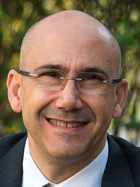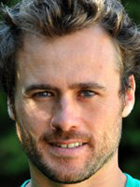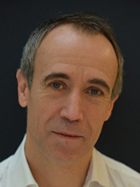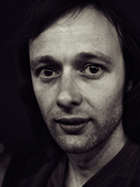 Frédéric Chavane Frédéric ChavaneInstitut des Neurosciences de la Timone – Marseille (France) Going backwards for a better visual prosthetic activation Retinal prostheses are promising tools for recovering visual functions in blind patients but, unfortunately, with still poor gains in visual acuity. Improving their resolution is thus a key challenge that warrants understanding its origin through appropriate animal models. Here, I will describe a systematic comparison between visual and prosthetic activations of the rat primary visual cortex (V1). We established a precise V1 mapping as a functional benchmark to demonstrate that sub-retinal implants activate V1 at the appropriate position, scalable to a wide range of visual luminance, but with an aspect-ratio and an extent much larger than expected. Such distorted activation profile can be accounted for by the existence of two sources of diffusion, passive diffusion and activation of ganglion cells’ axons en passant. Reverse-engineered electrical pulses based on impedance spectroscopy is the only solution we tested that decreases the extent and aspect-ratio, providing a promising solution for clinical applications. |
|
 Denys Fontaine CHU Pasteur – Nice (France) Denys Fontaine CHU Pasteur – Nice (France)
|
|
 Olivier Macherey Olivier MachereyLaboratoire de Mécanique et d’Acoustique, CNRS – Marseille (France) Auditory perception with a cochlear implant: limitations and future developments Cochlear implants (CIs) restore hearing sensations to profoundly-deaf people by electrically stimulating their auditory nerve. The information delivered by a CI is, however, limited and the success story of this neural prosthesis has probably a lot to do with our brain being able to make sense of speech sounds even when greatly distorted. I will illustrate in this presentation how sound signals are degraded by CIs and I will demonstrate that part of the information, despite being transmitted, is not correctly perceived or decoded by the listeners. I will then show several recent results suggesting that some aspects of auditory perception may be improved by modifying the electrical signal sent by the electrodes and I will develop possible future improvements. |
|
 Serge Picaud Serge PicaudInstitut de la Vision – Paris (France) Retinal prostheses and/or optogenetic therapy Blindness can result from the loss of photoreceptors in retinal diseases such as retinitis pigmentosa or age-related macular degeneration. Recent clinical trials have demonstrated the possibility to restore some visual perception by retinal prostheses. Patients were able to localize white squares on a dark screen or find doors in a room. One patient was even able to read simple words. Increasing the number of electrode is needed to allow better visual resolution for face recognition or autonomous locomotion and text reading. An alternative to electrical stimulation is provided by optogenetic therapy, which relies on microbial opsins to activate neurons. These microbial opsins are expressed by gene therapy in neurons transforming them into archaic photosensitive cells. The pixel size could thus become the cell size, which could further increase the resolution of stimulations. |
|
 Andreas Spiegler Andreas SpieglerInstitut de Neuroscience des Systèmes – Marseille (France) Stimulation effects in whole-brain network models When the brain is stimulated, for example, by sensory inputs or goal-oriented tasks, the brain initially responds with activities in specific areas. The subsequent pattern formation of functional networks is constrained by the structural connectivity of the brain. The effects of structural connectivity on the network response to stimulation were studied in a whole-brain network model comprising long- and short-range connections. The results suggest that the stimulus-induced brain activity, which may indicate information and cognitive processing, follows specific routes imposed by the network structure explaining the emergence of functional networks. Brain stimulation such as transcranial direct-current stimulation (tDCS) is a potential adjunct therapy in many psychological and neurological disorders. Using a whole-brain network model, the network and its states were investigated at rest and during tDCS. The results show how the network uses the repertoire, how new states arise, and how tDCS can alter the network and its functional connectivity. |




